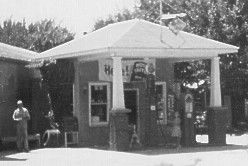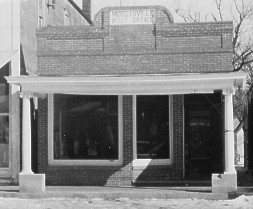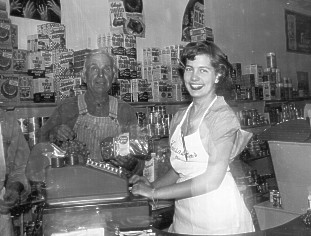Left: a young admirer inspects dolls from around the world in the window of Daniel Roenigk's insurance agency. The dolls were part of his daughter Barbara's collection. The display was made in anticipation of the "One World" pageant set for August 27; right: Barbara (Roenigk) Hart in 2013 with part of her doll collection.
With everything ready, Carson noted in her diary, "Beyond one of the oceans waits the town we're going to meet. ... This chance acquaintance with our unknown town must be more than routine friendship."
In many ways, the sister cities couldn't have been more different. Fèves could trace its origins back to Roman times when it was called Fabros. Morganville was so young that the first white child born there would attend the pageant. During the period of Morganville's existence, her difficult times were all inflicted by nature. During that same period, Fèves was a pawn in three major wars.
Leo Mellies' service station
Fèves, with a little help, could look forward to returning to those conditions that had existed before the war. In contrast, Morganville knew its future was uncertain. The settlers who had flooded into Clay County from the eastern states and from Europe after the Civil War caused the farm population to explode. Villages such as Morganville were necessary to supply the goods these farmers needed and to buy the farmers' products.
Morganville post office
But as farming equipment and farming methods became better, fewer men were needed to produce the crops and cattle. Farms began consolidating and many farmers' children left to find work in large cities. With that exodus, the number of customers visiting the village stores declined.
Better roads and vehicles hastened the effect. When the Post Office began Rural Free Delivery, a farmer no longer had to come
to town to collect his mail. Many items he used to buy locally, he could then order from a catalogue and have it delivered
directly to his farm. Even the people who lived in the small villages were inclined to shop in larger cities, where
the selection of goods was greater.
The result of these changes meant that the population of the rural areas peaked in the late 19th century and
then began a slow, but steady decline.
Henry Kolling and Rose Mina Oetinger in the Oetinger store
But although the villages were very different, the transformation from open prairies to settled farmlands and ranches
by people who had traveled far would be a compelling story when crafted by Carson's skilled hand.
Left: front of the Morganville Mercantile Company, advertised as the largest store in Clay County. After a fire, it was replaced in 1939 by what locals called the Stadium or amphitheater; right: Stadium in 2013. The photo was taken from what would have been the midpoint of the sidewalk in front of the store. The play was presented on the flat concrete stage before the brick wall. The orchestra was in front of the stage. The "old settlers" watched from the raised area behind the notch in the brick wall. The actors portraying Native Americans sat at the left, where the white fence can be seen beneath the tree, suggesting that they were "in the shadows," bystanders in a land that once was their own.






